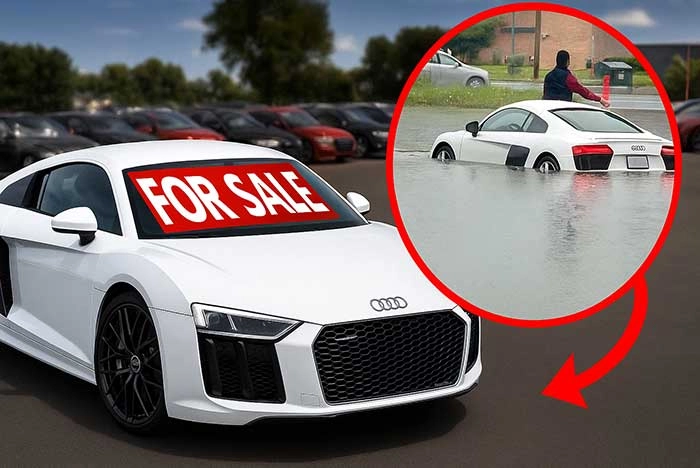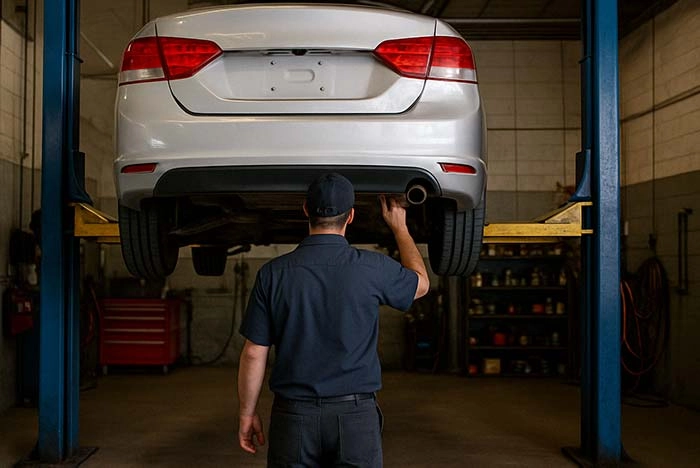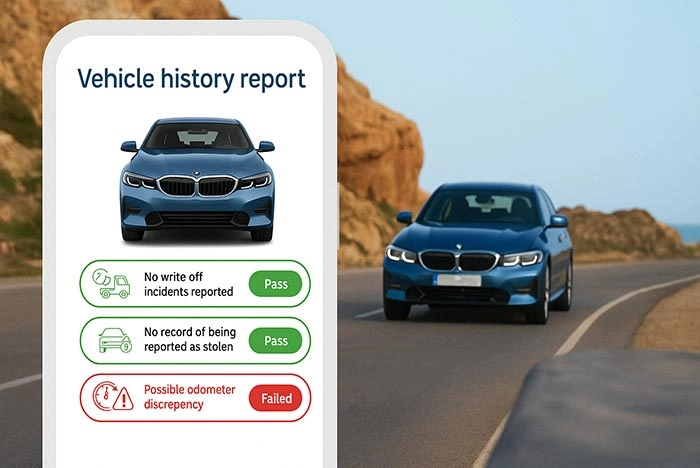
How to Check for Flood Damage in a Car – Signs of a Flooded Vehicle
How to Spot Signs of Flood Damage in a Used Car
Do you know that in 2024 there approximately 89,000 vehicles that have been damaged by flooding due to tropical storms and hurricanes in the U.S. That figure is in addition to an estimated 454,000 vehicle that are on the road with hidden flood damage.
The influx of these flooded vehicle in the used car market poses significant risk for unsuspecting buyers, as many of these cars can be cleaned up resold without disclosure or their condition.\
So, we will try to understand how can you tell if a car was in a flood and how to tell if you're buying a flood car to avoid a costly mistake. From visual signs like water stains to mechanical red flags, you’ll learn what to look for and why being diligent could save you from long-term headaches. We'll also explore the legalities surrounding flood-damaged cars and answer common questions about what dealerships do with them, and whether a flooded car can be fixed.
Signs of Flood Damage in a Used Car
In some vehicles that are flood damaged could not be visible and seems perfectly fine on the surface but can harbor hidden problems that may only become apparent mouths down the road. Here is a break down of the most common signs to look for hen determining whether a car has been involved in a flood.
1. Water Stain and Rust
Check the upholstery, seats, carpets, and roof lining for any watermarks or discoloration. Water stains are a clear indication that the vehicle has been exposed to water. Additionally, inspect areas like under the dashboard, inside door panels, and metal components under the seats for rust. Rust in places that don’t typically get wet is a major red flag.
2. Unusual Odors
A musty or moldy smell is often a giveaway of water damage. Mold and mildew can develop when water soaks into the car’s interior, especially in hard-to-reach areas like beneath the seats. If the car has an overpowering air freshener scent, this could be an attempt to mask these odors, so be cautious.
3. Electrical Issues:
Flood-damaged vehicles frequently experience electrical problems. Test all electronics in the car, including power windows, door locks, lights, and the infotainment system. Malfunctions or erratic behavior, such as flickering screens or unresponsive buttons, could be signs that the vehicle’s electrical systems were compromised by water exposure.
4. Mud and Dirt in Unusual Places:
Inspect hidden areas of the car where floodwater might have left dirt or debris, such as glove compartments, under the seats, and inside seat tracks. Additionally, check the trunk and the spare tire compartment for signs of mud or silt, which can be strong evidence that the car was submerged in floodwater.
5. Engine Compartment
Look for visible water lines around the engine compartment or on electrical components. If the air filter appears soggy or textured, it may have been exposed to water
6. Oil Inspection
Check the engine oil; if it appears milky or has an unusual consistency, this could indicate contamination from water
7. Seatbelts and Mounting Screws
Pull the seatbelts all the way out to check for water stains or discoloration along the straps. Inspect seat-mounting screws for signs of removal, which may indicate that the seats were taken out to dry the carpets
8. Foggy Headlights or Taillights
Condensation inside the headlights or taillights can be a clear sign that water has seeped into the vehicle’s interior. This happens when water enters the light assembly and dries unevenly, leaving moisture trapped inside.
How to Protect Yourself From Buying Flooded Car
If you haven't tested yet physically a vehicle and you don't have the time to mess around with every car you like, you need to cherry pick from the market the best possible solution. On top of that, the car should not be flooded. Here are some tips how to protect your self:
- Be Wary of Unusually Low Prices If a deal seems to go good to be true, usually it is not a good deal. There might be several factor such severe engine problem, the car is flooded or it had major accident. . If a vehicle is significantly cheaper than comparable models on the market, it may have been flooded and priced to sell quickly before any hidden damage becomes apparent. Sellers or dealerships may try to offload flood-damaged cars by offering steep discounts, hoping that the buyer won’t notice any issues until after the purchase.
- Check the vehicle VIN History One of the most reliable ways to check for flood damage is by running the Vehicle Identification Number (VIN) through a database at ProVINcheck. ProVINcheck's services provide detailed reports on a car’s history, including any reports of flood damage, accidents, or salvage titles. While VIN checks are not foolproof (since not all damage is always reported), they are a crucial step in identifying vehicles that have been involved in floods.
- Avoid Buying After Major Storms or Floods Flood-damaged cars often flood (pun intended!) the market in the aftermath of major storms, hurricanes, and natural disasters. These vehicles, once submerged in water, are often cleaned up and resold across the country, not just in the areas affected by the floods. Sellers may transport these vehicles to other regions where buyers are less suspicious of potential flood damage.
Extra Tips
- Get a Professional Inspection: Always hire a trusted mechanic to perform a thorough pre-purchase inspection before finalizing the purchase. A trained professional can often spot signs of flood damage that the average buyer might miss, such as corrosion on engine parts or electrical issues.
- Test Everything: When you test-drive the car, make sure to try all electrical components—windows, locks, lights, and infotainment systems. Look out for any glitches, delays, or malfunctions, which could indicate previous water exposure.
- Ask for a Warranty: If you’re buying from a dealership, ask if the vehicle comes with any type of warranty. A flood-damaged car may not be covered by traditional warranties, and a dealership that offers none may be trying to avoid liability for a problematic vehicle.
Can a Flooded Car Be Fixed?
The short answer is: it depends on the extent of the flood damage and which components were affected by the water. Some flood-damaged cars can be repaired to a safe and reliable condition, while others may have long-term problems that are difficult or costly to address. Let’s take a closer look at what factors determine whether a flooded car can be fixed, the risks involved, and what buyers should consider before purchasing or repairing one.
Type of Flood Damage
The severity of the flood damage is the most important factor in determining whether a car can be fixed.
- Freshwater Flooding: If the car was exposed to freshwater (e.g., from heavy rain or a river flood), there’s a better chance of restoring the vehicle, especially if the damage is caught early. Freshwater is less corrosive than saltwater, meaning it is less likely to cause long-term damage to metal components or electrical systems.
- Saltwater Flooding: If the car was submerged in saltwater, such as in coastal areas after a hurricane, the damage is often more severe and harder to repair. Saltwater is highly corrosive and can wreak havoc on the car’s electrical systems, metal parts, and engine components. Even after repairs, saltwater-damaged cars are more prone to long-term reliability issues and rust.
Dealership Practices and Legal Considerations
When buying a used car, it’s important to know that dealerships are usually required by law to disclose if a vehicle has been flood-damaged or given a "salvage" title due to flood damage. In most states, it’s illegal to sell a flood-damaged car without telling the buyer. However, some dishonest sellers try to get around this by "washing" the title, which means re-registering the car in a different state where the rules about title branding are more relaxed, making it harder to track the vehicle’s history. Always be cautious, run a proVINcheck, and ask for a full vehicle history report to avoid getting stuck with a car that has hidden damage.
FAQ
How can you tell if a car was in a flood? You can look for several tell-tale signs of flood damage, such as water stains on the upholstery, rust in unusual places (like under the seats or dashboard), or lingering musty odors. Foggy headlights, dirt in hidden places like glove compartments or under carpets, and malfunctioning electrical systems are also red flags. Additionally, you should always run a pro VIN check.
Is it illegal to sell a flood-damaged car? In most states, it’s illegal to sell a flood-damaged car without disclosing its history to the buyer. Sellers must inform the buyer if the car has a "flood" or "salvage" title, indicating serious damage. However, some sellers may try to hide this information by "washing" the title in states with more relaxed regulations, which is illegal but can be difficult to catch without a thorough vehicle history report
Can a flooded car be fixed? A flooded car can sometimes be repaired, but it depends on the extent of the damage. If the water was freshwater and didn’t reach the engine or electronic systems, the car might be salvageable with proper repairs. However, if the car was submerged in saltwater or if the water reached the engine or electrical components, repairs can be expensive and the car may never be fully reliable again
What happens to flood-damaged cars after they are declared total losses? Once a flood-damaged car is declared a total loss by insurance companies, it is typically branded with a "salvage" or "flood" title. These vehicles are often sold at auction to dealers or individuals who may attempt to repair and resell them. While it’s legal to resell flood-damaged cars, the seller is required to disclose the car’s history to potential buyers
hould I avoid buying a car after a hurricane or flood event? It’s wise to be extra cautious when buying a car in areas affected by hurricanes or floods, as many flood-damaged vehicles enter the market after such events. Unscrupulous sellers may clean up these cars to hide the damage and sell them in other states. Always inspect the vehicle thoroughly, check the VIN for any flood history, and have it inspected by a trusted mechanic before purchasing

